You’d be hard pressed to find a tactic more capable of winning and losing customers than personalization. In the past, bad personalization has cost businesses three-quarters of a trillion dollars. In the future, Gartner claims smart personalization will enable businesses to boost their profits by up to 15 percent:
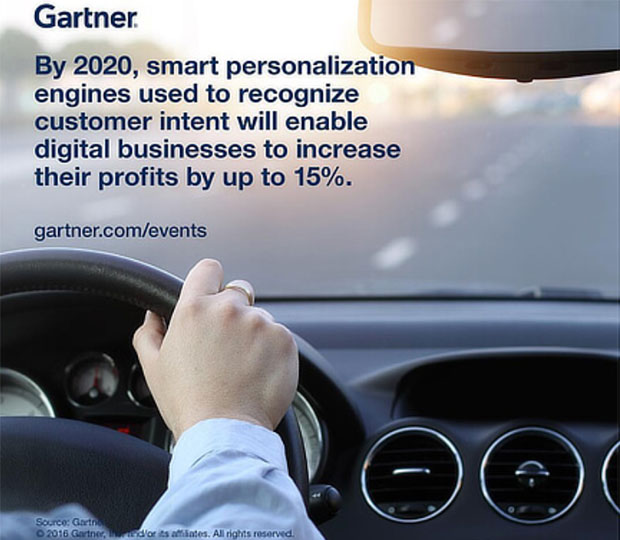
Today, personalization is everywhere — in B2B, B2C, e-commerce, SaaS — the list goes on. Unfortunately, the term “personalization” still carries much confusion with it, which is evidenced by the often-heard admonition that brands still aren’t getting it right.
The trouble is, personalization is hard — both to plan and to implement. It requires several stages of preparation that many businesses either don’t know about or skip altogether. Here’s what they are and why they shouldn’t
What Is E-Commerce Personalization?
E-commerce personalization is the process of serving specific marketing messages to targeted segments and subsegments of a given audience, with the goal of boosting e-commerce revenue.
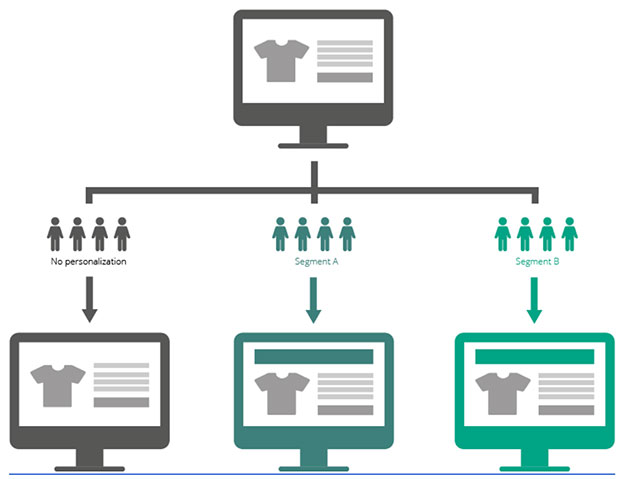
E-commerce personalization is built on the idea that every customer is different with respect to the problem that needs to be solved, the product needed to solve it, the way the customer gets that product (path to purchase), and how the problem is solved with that product.
To carry out e-commerce personalization effectively, a business must be able to do three things:
- Amass data on users. This could be, geographic, behavioral, demographic, etc.
- Analyze that data to find segments that may respond more favorably.
- Deliver an experience to that segment in real time.
Ultimately, the goal of these three preparational stages is to deliver more relevant content to users — but when stages are skipped or neglected, things don’t always go as planned.
Setting Up Personalization
The last several years have seen a major rise in adoption of personalization among marketers. Now, 98 percent of marketers agree that it advances the customer relationship.
As effective as it is, there’s a problem with the perception of personalization: It’s assumed it works, no matter the way it’s used or the goal it aims to achieve. That’s never the case for any tactic, regardless of how popular.
Personalization isn’t a one-size fix-all, which means that if you want to use it, you need to make sure it’s worth implementing.
You might argue that personalization is worth implementing, at least in some capacity. There are plenty of easy ways to “personalize” your content — from name in email to recommendations on product pages. Because they’re “easy,” many implement these tactics without consideration.
However, it’s not a question of whether you can get them done easily, but whether it is worth it right now for you.
Resist Getting Swept Up
It’s easy to get swept up in the obsession with personalization. As with any tactic, though, personalization methods require a strategic evaluation of business needs.
Is personalization where your resources are best spent right now? What are your goals, and how are you trying to achieve them?
For some, a universal user experience may work fine. For others, personalization may make sense. However, you should never implement a tactic for the sake of doing so, even if other businesses tout its effectiveness. In this case, you have to remember one all-important fact: Their business is not your business.
Cost vs. Benefit
Determining whether a tactic like personalization can work for you is as simple as performing a cost-benefit analysis. Work backward from your goals. What are you trying to achieve?
From there, lay out different routes for getting there. Is personalization the most effective route to accomplishing what you’re trying to do? Or are there other tactics that will move the needle more? Consider whether there are other tactics that will require significantly fewer resources than the personalization methods you’re trying to implement.
Personalization is as complex as you want it to be — and the more complex it gets, the more effective it can get, too. What’s also true is that the more complex it gets, the more difficult it can be to monitor. The more segments you create, the more you have to manage — and you have to manage them well. Poorly managed personalization is no personalization at all.
So You Want to Personalize
If you believe you’re prepared for personalization, you’ll have two ways to go:
- Personalization by business observations
- Personalization by machine learning
The first allows a member of a business to base its segmentation on observed factors in their data. This is similar to conducting any kind of optimization, in which you base your personalization on a test conducted, intuition, or qualitative/quantitative data. Say, prospects in different regions are showing very different buying preferences. That may push you toward creating personalized experiences for each.
The second, machine learning, allows you to use software to detect trends that are exploitable via personalization. Instead of your making the observation, it’s sophisticated software that does so in this case. Both methods are equally effective, though in the beginning, machine learning can be costly.
Once you’ve discovered methods for personalization, it comes time for another cost/benefit analysis. How personalized should you get?
The more rules for personalization you set up, the more complex it is to manage. The complexity of segmentation shows itself in future experiments, in support tickets, and in mismatches caused by machine or human error.
This is where tracking return on investment is crucial. You have to know whether a rule for personalization results in a boost in ROI. If it does, it’s worth replicating. If not, it’s simply costing you resources now, and will continue to drain them in the future, by boosting complexity without sustainable return.
15 E-Commerce Personalization Points
Think you’re reading to start using e-commerce personalization? Following are 15 methods that may work for your business.
1. Shoppable Social Media
The majority of Internet users access the Web via mobile device, and mobile device users spend most of their time in a select few apps. Among their favorites: social media.
At first, it doesn’t seem like a fact that benefits e-commerce businesses. However, research has shown that more than three-quarters of people have bought something they’ve seen on social media.
This leaves e-commerce brands with a unique and effective way to get into the wallets of their ideal customers: shoppable posts.
Shoppable posts feature images or videos of products, accompanied by a product page link that visitors can click on to shop. They can be as simple as these below from Urban Outfitters and Nike:
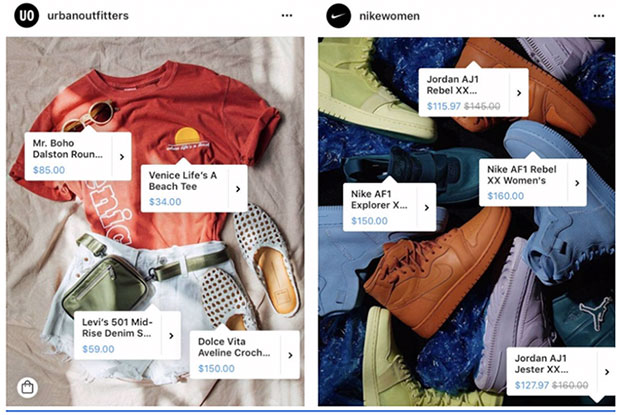
Or, they can look like a regular post, with a link in the description where visitors can find the content of the post for purchase:

Both are a great way to get products in front of your audience in a noninvasive way. They’ve constructed their feed, so they’ve opted into seeing your content. In this case, personalization is simply showing them what they’ve requested to see, but in a shoppable way.
2. Influencer Partnerships
Shoppable Instagram posts aren’t the only way to get into the feeds of your target audience. Accounts with large, engaged followings composed of your ideal prospects are perfect channels through which to advertise your product.
The benefit of influencer partnerships over shoppable posts is that they take advantage of a relationship between the user and the influencer. These posts aren’t just pictures of clothing, like the ones above. They’re personal recommendations from people your users trust, and the added social proof makes them infinitely more powerful.
3. Device-Specific Offerings
Context matters. Personalization isn’t just about the “who” shopping for the “what,” but “how” they’re shopping, too.
For example, someone shopping on a desktop computer or a tablet is very likely in a different mindset than someone shopping on a mobile phone. There’s a chance that the mobile phone user is actually out looking for a brick-and-mortar location that sells what they’re shopping for.
The desktop user, however, almost certainly is shopping from a fixed location with the intention of buying online. Offering in-store discounts to mobile users who are near your brick-and-mortar location is a great way to lure them in.
4. Geographic Product Offerings
However, personalization’s use isn’t limited to brick-and-mortar stores.
Even if you’re a local shop with one location, it’s unlikely you’re selling only to people in-store. What’s more likely is that your visitors span a variety of geographic regions.
If location is related to the products they may buy, consider personalizing your offerings the way Shop Direct did with its website, Very:
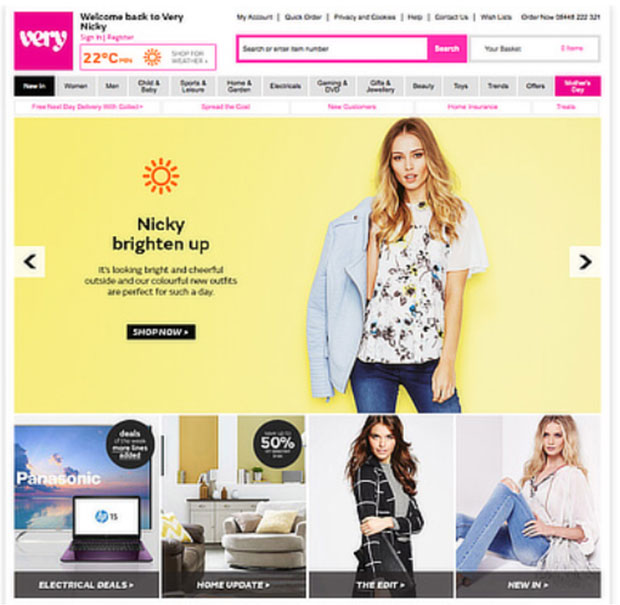
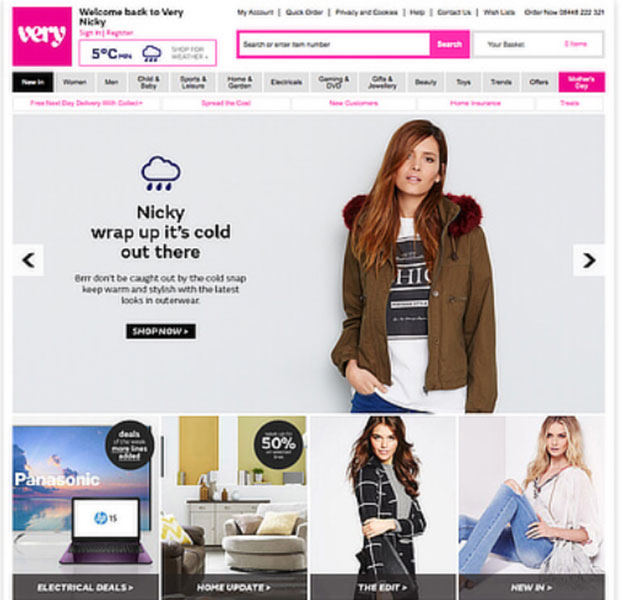
“We know that relevance wins in retail, and right now customers are drowning in a sea of irrelevant choices,” said Alex Baldock, Shop Direct group chief executive.
Personalization was just one of many ways to narrow the field.
Very unofficially was known to the e-commerce world as one of the first extensively dynamic personalized homepages. It didn’t just personalize them by geography, but showed users information based on browsing history as well. Today, the website can be delivered in an impressive 3.5 million different ways, depending on who’s visiting.
5. Time-Sensitive Product Offerings
Where geographic product offerings like the one above can make shopping for clothing a little easier, so can time-sensitive offerings.
To use clothing as an example, once again, it would mean highlighting the most popular shopping categories based on the time of year. In summer that might be dresses, while in winter it would be heavier coats.
If you were a sporting goods store, your homepage might highlight baseball products in the spring, basketball in the winter, football in the fall, etc.
This seems like a very basic form of personalization; however, even the basic things can make shopping a little easier. Making the path to purchase just a little bit easier can result in significant improvements in conversion rate.
6. Paid Search Landing Pages
One of the major issues facing personalization is the personalization gap. This results when only one half of an advertising campaign is personalized: the pre-click stage.
- The pre-click stage is everything that happens before a user clicks through an advertisement. That includes, but is not limited to, ad design, targeting, platform, etc.
- The post-click stage is everything that happens after a user clicks through an advertisement. That includes, but isn’t limited to, page load speed, landing page design, conversion ratio, etc.
Too many campaign creators still focus on personalizing the pre-click experience by tightening targeting, segmenting by platform and device, and then neglecting the post-click stage by sending their visitors to a homepage.
This creates a personalization gap: The user is served an offer with a great level of personalization in the ad, but then is made to look for that offer from a home page, or a landing page that isn’t targeted to that user.
For example, it’s not uncommon for someone who clicks an ad for “men’s dress socks” to be directed to the page for generic “men’s socks,” or even worse, “menswear.” This is poor user experience in that it promises something and then does not deliver on that promise.
Every promotion should have its own targeted landing page to match the ad in the pre-click stage. If you run an ad for “men’s dress socks,” then you should have a landing page for “men’s dress socks.” This is how campaigns should be run to meet the user’s expectations.
It’s one of those low-hanging-fruit fixes that many e-commerce businesses don’t know they can make, which can boost campaign performance almost immediately.
7. Off-Site Retargeting
On their first visit to your website, 98 percent of users don’t convert. Retargeting is the most effective way to get them back.
With off-site retargeting, reach visitors on their favorite website, social media platforms, and even in email to get them to reconsider purchasing with ads created from their browsing history.
Some say this method is “creepy” and “ineffective,” but there’s evidence to show exactly the opposite:
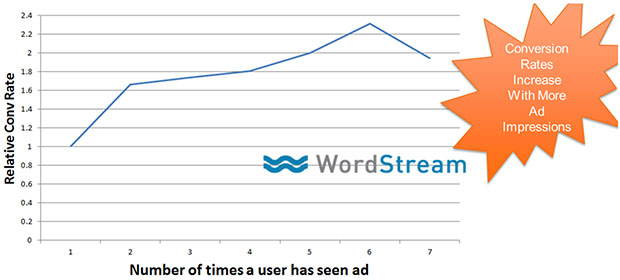
The key to succeeding with off-site retargeting is personalized listings. You can’t just show a generic ad for your website and expect it to entice visitors to return. Show them ads specific to their browsing history to increase the likelihood they click through to re-evaluate.
8. On-Site Retargeting
Like retargeting off-site, you can set up personalized pop-ups based on things like cart, session number and browsing history, both past and present. They’re a great way to supplement off-site retargeting, especially when you consider that the goal of off-site retargeting is to get people back to your website. With on-site retargeting, they’re already on your website — you just have to keep them from leaving.
This can be accomplished with contextual exit pop-ups. If it’s your visitors first time at your store, show a pop-up for 15 percent off their first order. If they’re shopping for shoes, show them the free shipping on sneakers pop-up. Too many exit pop-ups lead with a generic message. Make yours relevant to get visitors to reconsider leaving a great deal on the table.
9. Continuous shopping
The customer journey is long with, in some cases, countless touchpoints. That being the case, customers will arrive at your site, leave, then return — and they will repeat the process many times.
Sometimes the best thing you can do is get out of their way and simply make it easier for them to pick up where they left off. This is known as “continuous shopping.” Jan Soerensen, General Manager of Nostro North America, likens it to the Netflix “continue watching” section:
“Continue watching” is one of the most powerful features Netflix created. When we saw that, we realized we could apply it to e-commerce. Thus, continuous shopping recommendations was born, and it’s one of the tactics we recommend most to high-growth retailers.”
Amazon is known for personalizing its homepage in this way. When you return to the website, whatever you previously were browsing will appear on the homepage. When Shoeline used this method to personalize its homepage, based on browsing history, it earned a click-through rate of up to 26 percent and a conversion rate of 18 percent:
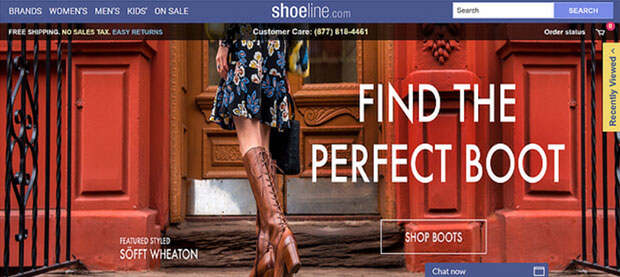
10. Intelligent recommendations
Recommendations may seem like a tired form of personalization, but they’re a tried-and-true way to boost e-commerce sales. In fact, Amazon makes 30 percent of its revenue from recommendations.
The key to great recommendations isn’t simply recommending another product based on the one that’s being viewed, but combining browsing history to offer a very specific, wide range of options.
For example, if you’re viewing a book called Knitting for Beginners, the common recommendation might be a more expensive, comprehensive version of a beginner’s knitting book. This is known as “upselling.”
However, an e-commerce business with troves of data can see that browsing histories indicate other people who have been interested in this book also have been interested in knitting needles and yarn. This is known as “cross-selling.” It’s also where Amazon gets its “frequently bought together” category at the bottom of product detail pages.
An e-commerce business can bring your browsing history into the equation, to see what you’ve been looking at in order to give you an even more-detailed recommendation. Maybe you previously bought a specific brand or type of yarn, which it can recommend to you again in a different color.
These are just a few ways to incorporate personalization data to offer better recommendations than ones based simply on the product you’re viewing.
11. Detailed Product Pages
If you’re the seller, the advantages of your product may be clear. Let’s use backpacks as an example. You think that most people simply want a backpack that can carry a lot of cargo, and that may be true.
However, if you create product pages based on “most people,” you may be neglecting a significant portion of your potential buyers. “Most” can be 90 percent of buyers, it can be 70 percent of buyers, or it can be 51 percent of buyers.
What you may not realize is that there are other significant numbers of prospects who base their backpack preferences on something else — or, at the very least, more than simply one main feature (I like the carrying capacity, but I don’t like the colors it’s offered in).
Consider these customer preferences:
- Want to be able to carry a lot, but want to look stylish as well. For them, pictures of all the different colors offered would be highly valuable.
- Want to be able to organize their cargo efficiently. For them, you might show photos of all the pockets in the bag, but also internal photos of compartments that can be used to divide up cargo.
- Want to be able to carry a very specific kind of cargo. Is there a place for me to store my water bottle for long hikes? Images and descriptions that confirm such a feature are valuable to this subset of prospects.
These are the kinds of things you need to take into account on your product pages. Show as many valuable images as possible, and create as much bullet-pointed copy as is necessary to completely describe all features of a product that may be attractive to different segments of your audience.
12. Post-Purchase Adjustments
While marketers associate personalization with revenue, the relationship isn’t always linear. In fact, you might argue that it sometimes seems to act in the opposite interest of earning business.
Consider Amazon’s “manage order” button. This allows buyers to adjust or even cancel their order after making a purchase.
For most businesses, this feature wouldn’t just be difficult to follow through on for logistical reasons — it also would face opposition from decision makers in the company. “You want to allow people to cancel their orders within a certain time frame, after we’ve gotten them to buy? Right. Sure. Great idea.”
Attitudes like that are short-sighted, however. Ultimately, it’s not the one-time buyer who will keep your business profitable, but the loyal customer who returns for repeat purchases. A personalized feature that allows customers to manage their orders on their own terms post-purchase, is exactly the kind of thing that makes people comfortable with purchasing in the future.
13. Programmatic Email Marketing
Email marketing is still considered the most valuable tool in a business’s arsenal. It’s reported to generate upwards of US$40 for every $1 spent.
While that number may be surprising, the sentiment is not. Consumers have indicated on more than one occasion that email is their preferred way of contact. It’s a very low-friction way of reaching out to them with timely offers, as opposed to telephone, which is much more intrusive.
Email’s power is fully realized when combined with programmatic capabilities that can serve behavioral recommendations for the following:
- products to be up-sold based on purchase history
- products to be cross-sold based on purchase history
- sales personalized by browsing history (e.g. mens/womens)
- sales personalized by geography
- sales personalized by time, etc.
The more specific your segments get, the more likely your visitors will respond to them. While time- and geographic-sensitive recommendations are effective, browsing history is likely to be where you see the most returns.
14. Content Marketing
Content marketing? For e-commerce? Absolutely.
One of the biggest problems consumers face is product overload. There are so many options out there that it’s hard to determine, on your own, which is the best for you.
This is where content marketing comes in. If I’m shopping for new running shoes but I’m not sure which are best for me, I’m probably going to search for a shoe-buying guide.
This one from REI is a great resource for someone in my position, and it even offers different ways to consume the content: text or video. It also positions REI as an authority on the subject of running shoes, and now I’m thinking: “These guys know their stuff, maybe I’ll browse their running shoes to see what they have for a runner like me.”
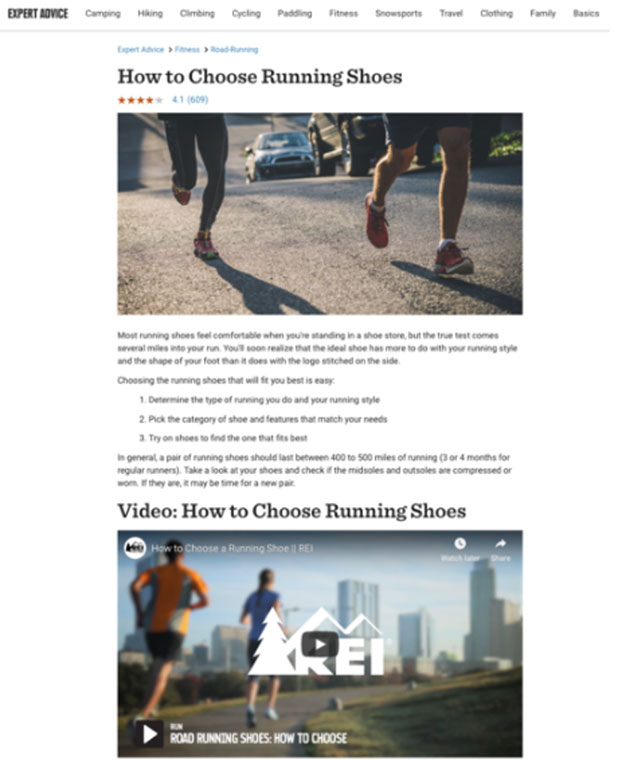
This isn’t just valuable before the sale, but afterward too. Part of getting customers to purchase with you again is to make sure they’re happy with their current purchase. A way to do that is by making sure they’re getting the most out of your product. The best part of this method is that you don’t even have to do it yourself (see below).
15. User-Generated Content
Arguably the best way to personalize content to your audience is to allow your audience to create it. User-generated content is exactly that: content created by your users with your product.
This content can be served via email or social media to inspire your customers to use your product in new ways, effectively by saying: “Look, here’s what so and so did with the product. You can too.”
GoPro is a great example of this. The more users upload different and innovative uses for their cameras, the more we’re able to see how versatile the product is.
Similarly, clothing and accessory brands have leveraged UGC by getting customers to submit different “looks” that prospects can steal from. For such a simple concept, the effect of UGC can be major.
One study of 559,276,000 online shoppers found the average conversion rate was 166 percent higher for visitors who saw UGC than for those who didn’t:
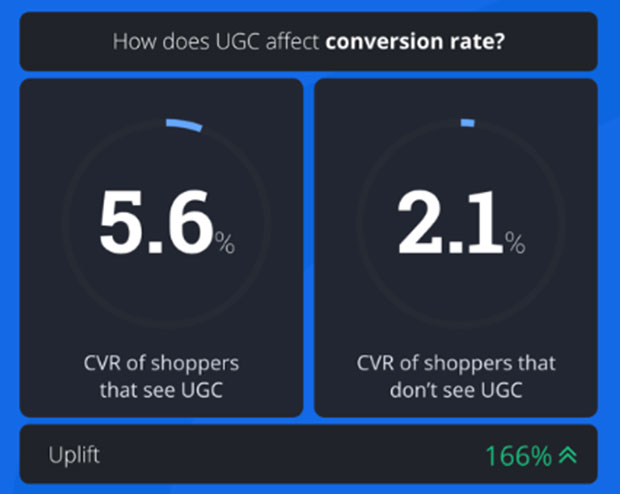
E-Commerce Personalization: Effective When Implemented Correctly
As with any flavor-of-the-week/year/decade tactic, there’s a lot of information on personalization out there. It can be overwhelming. The longer it goes on, the harder it becomes to tune out the noise and just, as they say, “do you.”
With e-commerce personalization, businesses need to do just that. While there are plenty of tactics on this list that you can start with, not all will be right for you today. Maybe none will.
However, they’re a great place to start when the time is right for e-commerce personalization to deliver the best return on your investment.




































eCommerce marketing is very important for all product related websites.